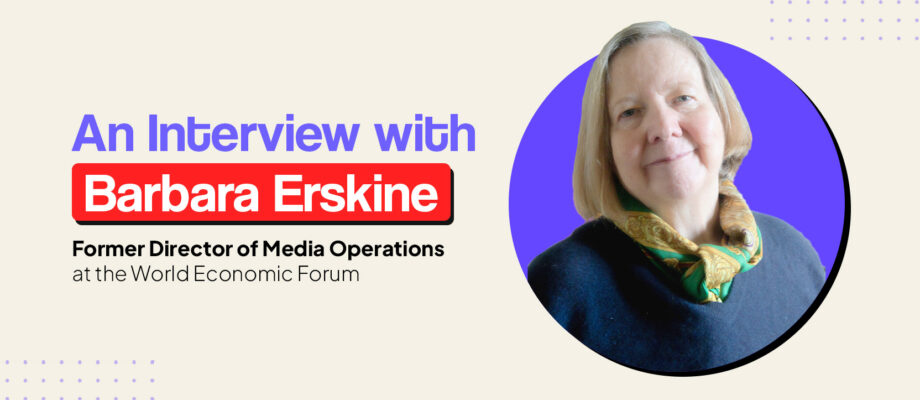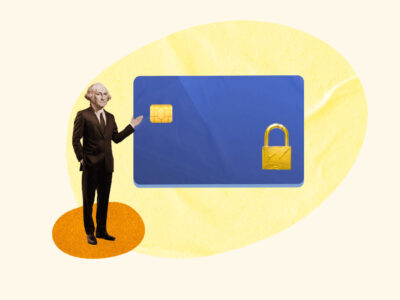As a follow-up to our article on the World Economic Forum conspiracy theory, we contacted several of its current and former employees for commentary. I heard back from Barbara Erskine, its former Director of Media Operations, who agreed to sit down for an interview.
Unless you’ve delved deep into the history of the WEF, you probably haven’t heard of Erskine. Like most of the Forum’s staff, she’s kept a low profile for most of her career, with the fame of the organization she worked for far eclipsing her own. Her web presence is negligible; she maintains a whimsical website that looks like a relic from a couple of decades ago, complete with a “website under maintenance” banner at the top.
However, Erskine was an instrumental part of the World Economic Forum in the 90s, a critical period in its history. She was responsible for managing its PR as it began to go truly global (and digital).
I spoke with Erskine about her 10-year stint at the Forum, as well as what she thinks about the conspiracy theories that have sprung up since she left.
Table of Contents
There’s a funny thing about setting up an interview with someone like Erskine—the second they agree to chat, all of the horrible things you wrote about their organization start running through your head, every snarky criticism or barbed joke.
However, Erskine wasn’t inclined to take us to task for any of that. She turned out to be upbeat and good-natured, and she maintained a matter-of-fact tone about her former employer throughout our talk. She still believes in the WEF and its mission, but she’s perfectly willing to acknowledge its faults, at least as she sees them.
“I didn’t find the article controversial,” she said.
There was only one time in our chat that Erskine showed any anger, and it wasn’t at us—but we’ll get to that in a minute.
Background and History at the WEF
Barbara Erskine has an interesting story. A journalist by training, she kicked off her career in 1985 working for The New York Times in their Paris Bureau. She remained there until 1990, when she moved to Switzerland and joined the WEF.
I asked her: how did that happen? What exactly drew her to the Forum?
Apparently, it was falling in love with a Swiss man.
“He was friendly, he was a musician, and he was spending a lot of time with me in Paris, but he didn’t want to,” said Erskine. “He wanted to live in Geneva, and I had to find a job there.”
She initially interviewed at World Link, the Forum’s magazine. However, the WEF’s PR team was looking to expand, and it swooped in and poached her.
Not everyone wanted to hire her, Erskine said. In her words, they “already had an American, and didn’t want this perception that the Forum’s PR was being dealt with by Americans.”
In the end, however, Erskine’s affinity for the media (which she described as “her world”) and her obvious rapport with journalists won out.
Although the Forum wasn’t what had originally brought her to Switzerland, she found that she identified with their aims, and she threw herself into her work.
Climbing the Ranks
Erskine wasn’t brought on at the director level. Her leadership role, which was also accompanied by a seat on the Forum’s executive board, came later.
“Let me tell you, I fought for that tooth and nail. Because, you know, the first thing anybody tries to do when you’re a young woman and you start somewhere is turn you into a secretary.”
Erskine avoided this fate by flatly refusing to do any secretarial work. Sticking to that wasn’t easy, but she got away with it by proving herself adept at handling the media. This arguably wasn’t surprising; after all, in her previous job, she had been the media.
Her work brought her into the orbit of Klaus Schwab, the architect and chairman of the Forum, and eventually he put her in charge of the WEF’s media relations.
“I finally stepped into the role,” said Erskine. “But it took me several years of fighting to get on the Board.”
A Day in the Life of a WEF Media Director
The Forum held events around the world, and at least half of Erskine’s time was spent on the road. She lit up when she described the traveling she did back then. “There was nothing mundane or routine about it,” she said. “It was just exciting. It was great to go around the world, meet the best journalists, invite them to our events and eventually bring them to Davos.”
Her days at the office were a different story.
By the time Erskine joined, the WEF had already acquired a reputation as a Big Deal. The discussions that went on behind closed doors at Davos had global significance. Remember 1988, when a brief but bloody war broke out between Greece and Turkey? No you don’t, because it never happened, and negotiations at Davos were a big part of why.
But behind closed doors, the Forum was far from a smoothly running machine. It had a staff of around 90 people, most of whom were crammed into a three-story villa in Cologny—
“No, no,” Erskine interrupted. “Not three stories. One story.”
Really, I said? I was sure I’d read sources that said three stories.
“Maybe it was three bedrooms, but all on one level. 90 people packed in there. At one point I was working in the terrace where they had put in a makeshift floor, a makeshift roof, and it rained. The offices were pint-sized. Practically no one had their own office, and all the doors were open. If someone was yelling at you, the whole office knew it.”
That was a common occurrence in the early 90s. At the time, the WEF had a managing director who Erskine referred to as “volatile.” She recalled one portrait of the organization published in the Financial Times in which the director was characterized as “a shrieking field general screaming her orders out from an office in the middle of the building.”
Given these working conditions, I asked, would it be fair to say that most of the people who were willing to work for the Forum were True Believers in its mission?
“We all were. We all were completely loyal, completely idealistic. You didn’t join the Forum, you joined a family, and it really was like a family.”
The Work Itself
The work was varied enough that no two days were the same. The Forum’s HQ was rife with office politics and there was always one crisis or another on the boil. Erskine recounted one day when Forbes magazine called her and requested a set of photos with an impossibly tight turnaround. With no other options (there was no internet at the time), she sent them by air.
The next day, someone stepped into her office and screamed at her, “Barbara, what did you do? Two hundred euros!”
“Look, if you don’t like it,” she said, “you can take it out of my salary.”
Erskine’s job also required her to absorb some of the Forum’s growing pains. The WEF’s members—all of which were businesses—weren’t comfortable with Klaus Schwab’s ambition to bring his organization into the realm of international politics.
The Forum’s members weren’t pleased. All this political stuff was too messy, they thought; Davos would be better off without it.
“My role was to handle the political grandstanding,” said Erskine. She did exactly that, despite the objections of the Forum’s members. “Peres and Arafat, or the heads of Greece and Turkey, those were big events. They made big headlines and they brought in big journalists, so we had to have that.”
A Lifestyle Job
Erskine recounted further work trips—strategic retreats, which featured bonding exercises that Klaus Schwab went for “before anybody else was doing them.”
“You were with your colleagues day and night. When you traveled with them, you just worked, you ate, and you slept, so you got to know everybody really well, and if you didn’t believe in it, you wouldn’t take it. It was hard. Very intense.”
Erskine reflected for a moment and laughed.
“My husband would always say that the worst thing you can do is put two people who work at the Forum together in a room together. All they’ll talk about is the Forum.”
Leaving the Forum
This grueling schedule did eventually take its toll, although it took a personal tragedy for Erskine to really feel its effects. Towards the end of Erskine’s 10-year career at the WEF, her husband died.
“It was terrible,” she said. “I had a lot of guilt about that because I was on the road and he was in Geneva dying. I was traveling and traveling and working all the time. I just felt terrible about that and couldn’t get over it.”
After that, Erskine lost her enthusiasm for the job. Klaus Schwab objected to her leaving, but she “just needed to stop,” and eventually he let her go.
It was an amicable parting. She remained in touch with the Forum and did occasional work for them for several more years.
She also did a stint as an editor for Wired magazine (even returning to Davos once on their behalf), and eventually she launched her own PR firm. Her clients since then have included UNICEF, the Bill & Melinda Gates Foundation, and the Swiss government.
Reflections on Some Well-Known Quotations
If you have, in fact, delved deep into the WEF’s history—if you’re the sort of person who lies awake at night fretting about what Klaus Schwab is plotting—there’s a chance you’ve already encountered Barbara Erskine, even if you don’t remember her name.
She’s been quoted in several prominent publications, and in her most famous quotes, she comes across as quite critical of Klaus Schwab.
Davos Man
One quote was published in Peter S. Goodman’s 2022 book, Davos Man, which contains several pointed critiques of the WEF and Klaus Schwab himself. In one anecdote, which was reproduced in Vanity Fair, Goodman tells the story of how Klaus Schwab delivered a speech in front of Nelson Mandela in which he cribbed a line from Martin Luther King Jr.—”I have a dream.”
The next line in the book reads:
“‘Several of us almost threw up,’ recalled Barbara Erskine, who then ran the Forum’s communications.”
While Erskine had mostly good things to say about Goodman’s book, she told me that line was misleading.
“He kind of turned that quote on its head,” she said.
On the page, it seems like a scathing criticism—but to hear Erskine tell it, she meant it as an expression of sheer astonishment rather than disgust.
“I thought I was going to fall over because it was just such a surprise to hear Schwab use that line,” she recalled. “But I don’t think I said that we were all going to be sick. I don’t think I said we’re going to throw up.”
The Wall Street Journal
Erskine had much harsher things to say about another quote, which was published in the Wall Street Journal.
In 2000, the WSJ published an article criticizing Klaus Schwab’s decision to branch out into for-profit ventures. It mentions one infamous incident, in which the Forum, which operates as a nonprofit and receives a certain amount of public funding, awarded a multimillion-dollar contract to a tech company. Less than two weeks later, that company elevated Klaus Schwab to its executive board and awarded him “valuable stock options,” which Davos Man claims may have been worth up to $500,000.
Many people found this ethically murky. Today, the story is sometimes cited by conspiracy theorists as hard evidence that Schwab cannot be trusted.
Barbara Erskine’s quote appears near the top of the WSJ’s article.
“That was my big problem,” says Barbara Erskine, the forum’s director of communications and a member of its executive board, who says she first raised the issue in 1997. “It just didn’t work. We’re a not-for-profit, but we started ventures that were bringing in money … . How could we explain that?”
Erskine’s words seem to lend credibility to the allegations of impropriety.
Lies, Damn Lies, and Quotations
When I asked Erskine about that line, her voice changed—the only time over the course of our conversation that she was anything other than cheerful.
“That was a very nasty, dirty trick that The Wall Street Journal played on me.”
“I never found out exactly who was behind it,” she said, “although Klaus’s nephew said that he had something to do with it. I think it was a direct attack on the Forum and on Klaus.”
Erskine described how the WSJ collected the quote:
“What they did was, they brought in this woman that nobody ever heard of before or after, the journalist Julia Flynn. While I was doing damage control with The Washington Post on the Forum’s finances, she came in and snuck around the back and asked me a lot of questions, which I answered the best I could.”
Erskine said that shortly afterwards, just before that year’s Davos event began, Flynn called her and asked her for permission to use her quotes. She said yes.
“And then she took them out of context and hung an entire negative piece on my quote.”
Really, I said. You were misleadingly quoted?
“Absolutely. My conversation with Klaus was about the Annual Report—just about the context of putting certain activities in the Annual Report if it wasn’t directly related to the foundation’s activities. That was it.”
So you never voiced concerns about the Forum stepping into for-profit ventures?
“No, no,” said Erskine. “And it was really bad, because then Klaus thought I was a traitor and I had made up this nasty story. I tried to convince them that even if I wanted to, I didn’t have any of that information. That wasn’t my domain. It wasn’t true.”
Views on the World Economic Forum Conspiracy Theories
It makes sense that Barbara Erskine doesn’t want to be associated with the WSJ piece, which contains some of the most lasting criticism that’s been leveled at the WEF. While she’s not afraid to speak her mind about the Forum, she ultimately stands by its mission and believes that it’s a force for good in the world.
I asked her if she’d heard of the online conspiracy theory we wrote about in our previous article—”you’ll own nothing and be happy.” She said she hadn’t, but that conspiracy theories around the WEF have “always been there,” a kind of constant background noise to its activities.
According to Erskine, WEF has employed some clever strategies for dealing with its detractors.
“The really smart thing the Forum did—” She broke off and amended. “Actually, it was a woman who worked for me who was able to do it. It was to co-opt that energy and turn it into another branch of Davos.”
Erskine was referring to the Public Eye on Davos, which was founded as a deliberate counterweight to the WEF’s yearly meeting. There have been several other groups with the same idea, including the World Social Forum, which held its first meeting in 2001 in Porto Alegre.
The goal was to “have a kind of Forum outside of the Forum for the people protesting,” said Erskine. “But eventually it became the Forum organizing it.”
This strategy is fairly typical of the WEF—neutralizing their critics by co-opting them. It’s reminiscent of another anecdote from a 2012 New Yorker article, in which the WEF throws a group of protesters into disarray by inviting them in.
Depending on your perspective, tactics like this might seem unsettling, a Machiavellian twist affirming all your worst fears about the WEF. Or they could just seem like clever PR.
Dealing with the Internet
That might have been a viable strategy back in the 90s and 2000s, when the WEF’s most vocal opponents were in-person protesters. It’s much tricker today, when they’re faced with thousands of anonymous internet commentators—people who can’t even be found, much less co-opted.
In a way, this problem can trace its roots back to 1996. That’s the year that the Forum went digital, when Barbara Erskine launched their first website.
Like most people in the middle of the dot-com boom, she was deeply excited by the possibilities of the internet, which offered the chance to disseminate the Forum’s message to a global audience.
She had no inkling that the internet would one day present a major problem for the Forum, or that it might inflame the conspiracy theories that were already quietly circulating around the outskirts of Davos.
“Perhaps in hindsight it wasn’t the right way to think, but we thought of [the conspiracy theorists] as marginal. We thought we were doing good and bringing good. You know, the Forum doesn’t do anything. They only bring people together.”
Sleeping on the Job
Erskine paints a very different picture of the Forum than the one you’ll find on social media. On Facebook and Twitter, thousands of people are convinced that the Forum does indeed do something, and they’re prepared to tell you—in exhaustive detail—exactly what that something is.
When asked about the Forum’s dismal online reputation, Erskine was blunt:
“I was thinking this year that somebody had let their guard down, because there was too much of this negative stuff getting out.” During her tenure, she said, part of her job was to track down where negative publicity was coming from and figure out who was behind it and why. “Now it looks to me as if somebody just let it go. Maybe ten or twelve months ago, I was really thinking—gee, who laid down on the job?”
She acknowledged that part of the problem might be that “the world is so big now.”
Perhaps it’s impossible to control an organization’s reputation in the digital space, where discussions can explode in unpredictable ways, where many of the participants are anonymous, and where anything can seem sinister when taken out of context.
“And everything is out of context, right?” she quipped.
Fixing the WEF’s Damaged Reputation
In our previous article on WalletCrowd, we speculated that part of the problem with the WEF is that, as an exclusive club for the wealthy and powerful, it just isn’t the kind of organization that people trust in today’s political climate. On the contrary, people are predisposed to believe the absolute worst of it.
Is there any way, I asked, to fight the image of the Forum as an elitist organization where the ultra-rich can discuss things behind closed doors?
“You know,” said Erskine, “I was talking to a colleague who’s still very much involved, and he said that one of the things he thought would help its reputation and perception would be to actually leave Davos.”
She paused.
“And I think that he’s right.”
This seemed like such a bold suggestion that I was caught off guard. After all, “Davos” is practically synonymous with the World Economic Forum. It’s one of a handful of cities that have become, through metonymy, a stand-in for something else, the way people say “Washington” when they mean “the US government.”
Let’s say you did that, I said. Where would you relocate the Davos event to?
“I don’t know that you’d have to relocate anywhere. Do it online. Do it online and be transparent.”
A Digital Davos
Erskine sketched a quick picture of a digital symposium, an open event that anyone could join. Converting the WEF’s meeting into that would mean abandoning the glitz and glamour that it’s become known for, but in a way, that might actually be closer to what Schwab claims his vision is.
In Davos Man, Goodman writes that many attendees at Davos spurn the actual talks and conferences in favor of outside parties, which he calls “notorious soirees full of privileged debauchery.”
If Schwab is to be believed, he’s not a fan of these notorious soirees. He told the New Yorker in 2012, “We do not welcome them. They detract from what we are doing … People know that I am very much against caviar and champagne and expensive wines, which are out of character with the atmosphere of a mountain village.”
In the end, the best way to ditch the caviar and champagne might be to ditch the mountain village itself—or to construct a virtual one.
I suggested that this would also avoid the spectacle of people showing up in private jets and talking about climate change, the irony and hypocrisy of which has clung to Davos for many years.
“Exactly!” said Erskine. “How is that for the environment? But that’s the same thing for the UN conferences—it’s ridiculous. How can they have a conference about the environment and have everybody take jets to go there? It’s crazy. So I think that would help, to take it into the virtual.”
Some of Erskine’s current work involves the creation of virtual spaces—metaverses, essentially, to borrow the term that Mark Zuckerberg popularized in 2021. She said that Klaus Schwab was working on a metaverse of his own.
“I think the metaverse might be a good solution for him—if he manages to control the perception that it’s only for the 1%.” Another pause. “Which maybe he never will be able to do.”








